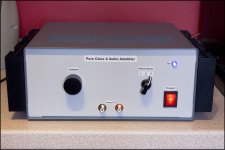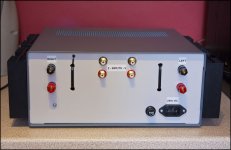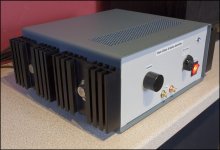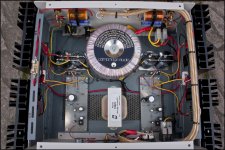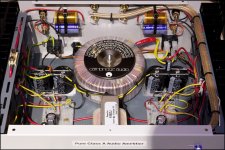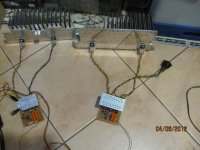HI
I fire up the other channel last night but the bias start from about 1.5 amp and climb rapidly. The tip 3055 is dead within 30sec !
I will do troubleshooting tonight. Any pointers would be much appreciated.
VR2 is 20 K +10 K
Are you tracking the bias with 1ohm resistor in the +ve supply? If you are then make sure the resistor is within 1%(or at least 5%) tolerance of 1ohm because the resistance will have a direct influence on measured voltage around it(and the measured current through it).
Any need for matching the hfe of the TIP 3055?
Not necessary for normal operation, but matching will definitely result into less distortion.
Is there any likelihood of BD 139 damage?
You seem to have installed large heatsinks for the BD139s, if their thermal contact is insulated then they should be okay. The load placed on them is not as high as the output transistors, only 100mA at most, so with proper heatsinking they will not fail.
Is the quality and quantity of C3 critical in sound quality?
kp93300
The minimum value for this bootstrap capacitor is 33uF for good bass response at high volume, you can increase its value upto say 220uF without any problem. Too large value will result in amplifier startup delay as it will take longer to charge a large cap than a small cap. The quality of this cap is also important. Use the best you can afford. Audio grade caps are most welcome.
Last edited:
MOUKD any more input about the sound of your DOZ?
kp93300
Hi. Yes, I took a video, but forgot to post it here. I'm not one to go into tremendous detail. Like a fine wine, it just 'tastes nice'. I can't tell you about the fruity flavours or what food it goes well with 😀
Here is a video tour of it: Class A Death of Zen (DoZ) - YouTube
I know you are building a slightly different circuit, but I found the idle current fiddly to set. It could probably be designed better on the schematic. Still once its set, it seems to be ok, so i'll probably leave it now.
I am very pleased with it, it sounds great, frequency response is good, its amazing how loud 10w is! It will be permanently replacing my Pioneer A-676 integrated amp which will be going on a well known auction site to help pay for the DoZ parts!
Cheers all 😉
Attachments
Beautiful DIY job! Congrats M0UKD! You've built a great Class-A amplifier. You've found "the" sound, where just 10W of it can drop jaws! I'm damn jelly... the finished cabinet looks super-cool!
Here is a video tour of it: Class A Death of Zen (DoZ) - YouTube
Incredible! 😱
John, what you have done is the second biggest contribution to the DOZ project after the original DOZ article. With this available many new DOZ builders here will have a more complete idea of the potentials of this great amplifier.
I don't own a scope, so seeing the DOZ's output through your scope is a complete priviledge. And you have also done very well at describing the functions of various parts of the whole amplifier.

THANKS very much for sharing your experience.

22degrees in UK now? I'm burning at 40degrees here... just a matter of time before my 3055s explode! 😀
Last edited:
It's back down to 2°C today. White stuff all around. Last week, we hit a new Scottish March record of 24°C
Hi
I spend 2 hrs last night to troubleshoot.
I forgot to earth the non inverting input of the TL 72 !
MOUKD, nice video and thanks for the input .
regards
kp93300
I spend 2 hrs last night to troubleshoot.
I forgot to earth the non inverting input of the TL 72 !
MOUKD, nice video and thanks for the input .
regards
kp93300
KP93300, is it running okay now?
Hi Shaan,
It is playing beautiful music right now through my test speakers !!😀
Power input is +/_ 22.5 V.
Bias current is running around 1.7 to 1.8 amp. It is not rock steady .
After running for 30 minutes, the temperature at the screw for the TIP3055 measure about 70 deg c.
No dc at the speaker output.
I will let it run it longer before hooking up to the main speaker.
Thanks Shaan.
Hi MOUKD,
Very nice video and neat construction . It is nice to know the flat freq response between 20 to 20K HZ !
regards
kp93300
Hi Shaan,
It is playing beautiful music right now through my test speakers !!😀
Power input is +/_ 22.5 V.
Bias current is running around 1.7 to 1.8 amp. It is not rock steady .
After running for 30 minutes, the temperature at the screw for the TIP3055 measure about 70 deg c.
No dc at the speaker output.
I will let it run it longer before hooking up to the main speaker.
Thanks shaan
Nice to hear that you too like its sound! 🙂 Let us know when you are over then moon... ;D
70deg c on the 3055s seems too high... is the main heatsink doing its job properly?
Upload more photos... everybody here loves amp-porns...
Cheers.
heat torture
Hi
Picture of both channel under heat torture !
How do i adjust the gain ? With the lightspeed clone ( LDR volume control ) It sounds pretty loud at 8 oclock . This is a 10 K pot .
Tried with a 100K passive pot, it is also very loud at 9 oclock .
It is much louder than JLH 69 .
Hi Shaan,
I thought TIP 3055 has a maximum operating Temp of 150 deg C .
I have run both channels continuously fro about 5 hrs without failure.
The heatsink temp is about 55 C and temp at the TIP 3055 is about 70 deg .
I will build a cap multiplier and a speaker protection relay eventually.
I am going to place this on a large chopping bard .
The trans is housed in a separate box and will be shared with the F5 and Aleph J .
thanks
kp93300
Hi
Picture of both channel under heat torture !
How do i adjust the gain ? With the lightspeed clone ( LDR volume control ) It sounds pretty loud at 8 oclock . This is a 10 K pot .
Tried with a 100K passive pot, it is also very loud at 9 oclock .
It is much louder than JLH 69 .
Hi Shaan,
I thought TIP 3055 has a maximum operating Temp of 150 deg C .
I have run both channels continuously fro about 5 hrs without failure.
The heatsink temp is about 55 C and temp at the TIP 3055 is about 70 deg .
I will build a cap multiplier and a speaker protection relay eventually.
I am going to place this on a large chopping bard .
The trans is housed in a separate box and will be shared with the F5 and Aleph J .
thanks
kp93300
Attachments
My experience with Capacitive Multipliers has been disappointing.
I would recommend a decent CRCRC circuit rather than a C.M.
The impedance of the C.M. is quite high and can affect the frequency response of the amplifier.
I would recommend a decent CRCRC circuit rather than a C.M.
The impedance of the C.M. is quite high and can affect the frequency response of the amplifier.
Pd = Pmax * [Tmax - Tc] / [Tmax - T25]
using Pmax = 120W
Tmax = 150°C
Tc = Ts + 15Cdegrees = 70+15 = 85°C
The maximum power of the 3055 with a 70°C heatsink interface temperature is de-rated to ~ 120 ~ 65 / 125 = 62W.
Running the hottest part of the heatsink @ ~70°C effectively reduces your 3055 to a 62W device. Then you must de-rate for second breakdown at all the higher Vce imposed on the 3055.
Some 3055 have a Pmax of 90W @ Tc=25C.
using Pmax = 120W
Tmax = 150°C
Tc = Ts + 15Cdegrees = 70+15 = 85°C
The maximum power of the 3055 with a 70°C heatsink interface temperature is de-rated to ~ 120 ~ 65 / 125 = 62W.
Running the hottest part of the heatsink @ ~70°C effectively reduces your 3055 to a 62W device. Then you must de-rate for second breakdown at all the higher Vce imposed on the 3055.
Some 3055 have a Pmax of 90W @ Tc=25C.
My experience with Capacitive Multipliers has been disappointing.
I would recommend a decent CRCRC circuit rather than a C.M.
The impedance of the C.M. is quite high and can affect the frequency response of the amplifier.
My experience is the exact opposite.
I built the simple cap-multiplier in ESP site. Installed a 1000uF AFTER the multiplier as suggested in the webpage.
Result:- No hum, Excellent frequency response in DOZ, as if there is nothing but wires between the DOZ and the main PS caps.
Currently I use a simple CRC which gives the same hum-reduction plus bias-monitoring plus low-impedance. However, the multiplier was equally good, it just used extra components.
Last edited:
Pd = Pmax * [Tmax - Tc] / [Tmax - T25]
using Pmax = 120W
Tmax = 150°C
Tc = Ts + 15Cdegrees = 70+15 = 85°C
The maximum power of the 3055 with a 70°C heatsink interface temperature is de-rated to ~ 120 ~ 65 / 125 = 62W.
Running the hottest part of the heatsink @ ~70°C effectively reduces your 3055 to a 62W device. Then you must de-rate for second breakdown at all the higher Vce imposed on the 3055.
Some 3055 have a Pmax of 90W @ Tc=25C.
Parallel 'em .
My experience is the exact opposite.
I built the simple cap-multiplier in ESP site. Installed a 1000uF AFTER the multiplier as suggested in the webpage.
Result:- No hum, Excellent frequency response in DOZ, as if there is nothing but wires between the DOZ and the main PS caps.
Currently I use a simple CRC which gives the same hum-reduction plus bias-monitoring plus low-impedance. However, the multiplier was equally good, it just used extra components.
If you've got the parts, try them both. At the end of the day it will be you listening to it.
If you've got the parts, try them both. At the end of the day it will be you listening to it.
Yes. So let's stop talking about power supply as this is the DOZ thread. Peace.
Please Post DOZ Things Only. Thank you.
OK - not trying to thread hop here.
The PSU is a vitally important part of any Class A amplifier project.
I'll leave it up to the builders to try what they may.
The PSU is a vitally important part of any Class A amplifier project.
I'll leave it up to the builders to try what they may.
Hi AndrewT
Thanks for your input.Your calculation is good but I am electronic illiterate.
Can you advice what is the optimum operating temp for the TIP 3055? The solution is to use a bigger heatsink or fan ?
Hi Shaan,
How to adjust the gain of DOZ ?
thanks
kp93300
Thanks for your input.Your calculation is good but I am electronic illiterate.
Can you advice what is the optimum operating temp for the TIP 3055? The solution is to use a bigger heatsink or fan ?
Hi Shaan,
How to adjust the gain of DOZ ?
thanks
kp93300
- Home
- Amplifiers
- Solid State
- Death of Zen 15 watt Power Amplifier
